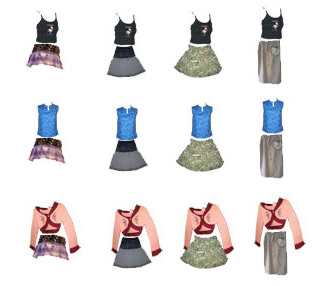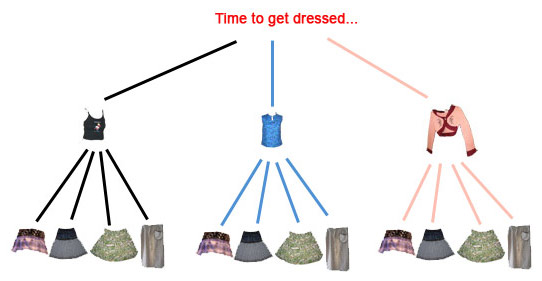Foreshadowing: Combinatorics
This module will make heavy use of the 'Law of Combining', which you probably learned in grade school, but without the fancy name. For example, in grade school you got a problem something like this:
Nancy Drew, girl detective, is heading out to Solve the Case. She has 3 blouses and 4 skirts in her closet (the housekeeper is behind on the laundry). How many different outfits can Nancy make?
Here is one way to visualize Nancy 's outfits:

Here is another way (called a tree diagram):

Either way, you have to agree that Nancy has 12 possible outfits (although her father, famous lawyer Carson Drew, will probably veto the tank-top/miniskirt combination).
You will probably also have noticed that 12 = 3 * 4, which is not a coincidence. There are 3 kinds of tops Nancy could put on, and for each of these, she could choose 4 skirts.
The Law of Combining says:
If you want to count the possible combinations of ONE PICK from set 1 and ONE PICK from set 2, you can just multiply the size of set 1 by the size of set 2.
Or simply,
Ntot = N1 * N2
After the Drews' housekeeper catches up with the laundry, Nancy has 17 blouses and 32 skirts. How many outfits can she make?
(To make this problem interactive, turn on javascript!)
- I need a hint ... : remember to multiply the number in the first set by the number in the second set.
- ...another hint ... : the first set consists of 17 blouses...
I think I have the answer: 544.
No calculator? Just pull out your trusty slide rule.
No slide rule? Go to Google, type in the equation (i.e., "17*32=") and hit enter!
No browser? Get Firefox! Web designers everywhere will thank you. And you can tab to a new page to make your calculations on Google.
Copyright University of Maryland, 2007
You may link to this site for educational purposes.
Please do not copy without permission
requests/questions/feedback email: mathbench@umd.edu